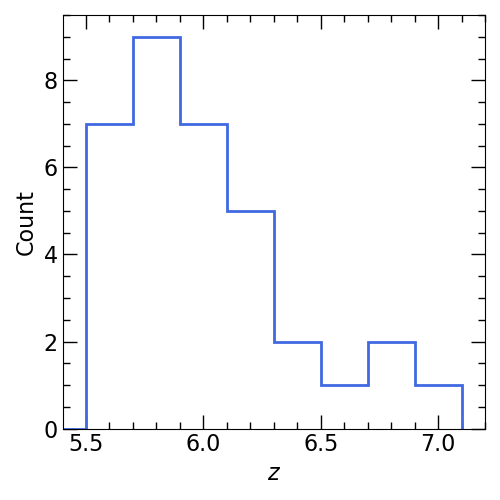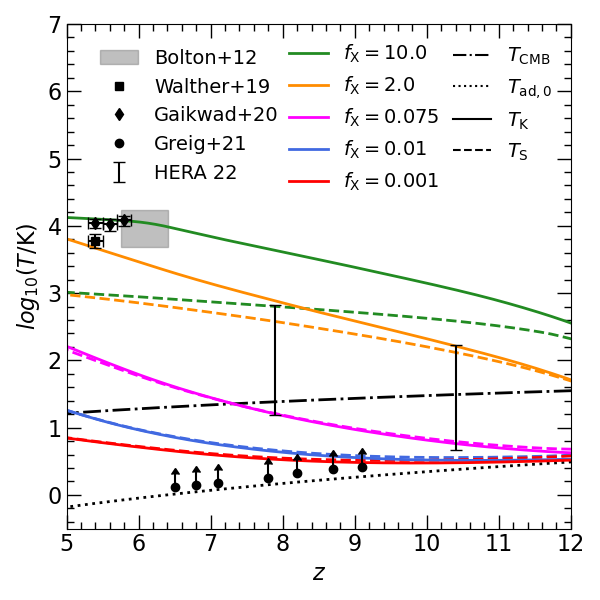Epoch of Reionization data
Here you can find compilations of observational data from the Epoch of Reionization.
Radio-loud sources at \(z>5.5\) - currently 34 radio-loud quasars + 1 radio galaxy
\(*\) corresponds to a radio galaxy while others to radio-loud quasars.
If you find this compilation useful, please consider citing Šoltinský et al. 2025.


Left: Redshift distribution of \(z>5.5\) radio-loud quasars. All of these radio-loud quasars and some information about them (name, redshift, intrinsic flux density at \(147\,\rm MHz\), spectral index between \(1.4\,\rm GHz\) and \(147\,\rm MHz\), references) are listed in the table above. An excel spreadsheet containing this information can be downloaded here.
Right: Temperature evolution at mean density for different X-ray background radiation efficiency, \(f_{\rm X}\), and comparison with observational data (listed below, excel spreadsheet here). The computation of this is described in the Appendix B of Šoltinský et al. 2021. Hence, if you find this useful, please consider citing this paper.
Temperature measurements at \(z\geq5\)
| \(z\) | \(T(\rm gas\, kinetic)/\rm K\) | \(T(\rm spin)/\rm K\) | Method | Reference |
|---|---|---|---|---|
| \(15.0\) | \(5.0-7.7\) | \(6.4-33.9\) | Cosmic X-ray background, UV luminosity function, 21-cm power spectrum | Dhandha et al. 2025 |
| \(12.5\) | \(3.6-16.0\) | \(4.5-19.0\) | Cosmic X-ray background, UV luminosity function, 21-cm power spectrum | Dhandha et al. 2025 |
| \(10.0\) | \(2.5-66.2\) | \(3.1-73.3\) | Cosmic X-ray background, UV luminosity function, 21-cm power spectrum | Dhandha et al. 2025 |
| \(8.0\) | \(3.7-349.5\) | \(4.3-359.2\) | Cosmic X-ray background, UV luminosity function, 21-cm power spectrum | Dhandha et al. 2025 |
| \(6.0\) | \(19.8-2077.9\) | \(19.0-1258.1\) | Cosmic X-ray background, UV luminosity function, 21-cm power spectrum | Dhandha et al. 2025 |
| \(10.4\) | \(3.2-313.2\) | \(4.7-171.2\) | 21-cm power spectrum | HERA 2023 |
| \(7.9\) | \(13.0-4768.0\) | \(15.6-656.7\) | 21-cm power spectrum | HERA 2023 |
| \(9.1\) | \(>2.6\) | 21-cm power spectrum | Greig et al. 2021a | |
| \(8.7\) | \(>2.4\) | 21-cm power spectrum | Greig et al. 2021b | |
| \(8.2\) | \(>2.1\) | 21-cm power spectrum | Greig et al. 2021b | |
| \(7.8\) | \(>1.8\) | 21-cm power spectrum | Greig et al. 2021b | |
| \(7.1\) | \(>1.5\) | 21-cm power spectrum | Greig et al. 2021b | |
| \(6.8\) | \(>1.4\) | 21-cm power spectrum | Greig et al. 2021b | |
| \(6.5\) | \(>1.3\) | 21-cm power spectrum | Greig et al. 2021b | |
| \(5.8\pm0.1\) | \(12000\pm2200\) | Ly\(\alpha\) transmission spikes | Gaikwad et al. 2020 | |
| \(5.6\pm0.1\) | \(10500\pm2100\) | Ly\(\alpha\) transmission spikes | Gaikwad et al. 2020 | |
| \(5.4\pm0.1\) | \(11000\pm1600\) | Ly\(\alpha\) transmission spikes | Gaikwad et al. 2020 | |
| \(5.0\) | \(7370^{+1670}_{-1390}\) | Ly\(\alpha\) forest power spectrum | Boera et al. 2019 | |
| \(5.4\) | \(5990^{+1520}_{-1340}\) | Ly\(\alpha\) forest power spectrum | Walther et al. 2019 | |
| \(5.0\) | \(5330^{+1220}_{-910}\) | Ly\(\alpha\) forest power spectrum | Walther et al. 2019 | |
| \(6.08\pm0.33\) | \(5888^{+824}_{-1060}\) | Ly\(\alpha\) absorption lines | Bolton et al. 2012 |
Neutral Hydrogen fraction measurements at \(z\geq5\)
| \(z\) | \(x_{\rm HI}\) | Method | Reference |
|---|---|---|---|
| \(10.40\) | \(1.00^{+0.00}_{-0.40}\) | GP trough, Damping wing | Umeda et al. 2025b |
| \(8.60\) | \(1.00^{+0.00}_{-0.20}\) | GP trough, Damping wing | Umeda et al. 2025b |
| \(7.00\) | \(0.65^{+0.27}_{-0.35}\) | GP trough, Damping wing | Umeda et al. 2025b |
| \(5.80\) | \(0.25^{+0.10}_{-0.20}\) | GP trough, Damping wing | Umeda et al. 2025b |
| \(5.00\) | \(0.00^{+0.12}_{-0.00}\) | GP trough, Damping wing | Umeda et al. 2025b |
| \(7.30\) | \(0.75^{+0.09}_{-0.13}\) | Ly\(\alpha\) luminosity function | Umeda et al. 2025a |
| \(7.00\) | \(0.18^{+0.14}_{-0.12}\) | Ly\(\alpha\) luminosity function | Umeda et al. 2025a |
| \(6.60\) | \(0.21^{+0.19}_{-0.14}\) | Angular coorrelation function | Umeda et al. 2025a |
| \(6.60\) | \(0.15^{+0.10}_{-0.08}\) | Ly\(\alpha\) luminosity function | Umeda et al. 2025a |
| \(5.70\) | \(0.06^{+0.12}_{-0.03}\) | Angular coorrelation function | Umeda et al. 2025a |
| \(5.70\) | \(<0.05\) | Ly\(\alpha\) luminosity function | Umeda et al. 2025a |
| \(9.30\pm1.30\) | \(0.64^{+0.07}_{-0.13}\) | Damping wing | Mason et al. 2025 |
| \(6.50^{+1.50}_{-1.00}\) | \(0.33^{+0.08}_{-0.17}\) | Damping wing | Mason et al. 2025 |
| \(11.00^{+3.18}_{-1.38}\) | \(0.88^{+0.11}_{-0.13}\) | Ly\(\alpha\) equivalent widths | Kageura et al. 2025 |
| \(8.41^{+1.02}_{-0.90}\) | \(0.79^{+0.13}_{-0.21}\) | Ly\(\alpha\) equivalent widths | Kageura et al. 2025 |
| \(6.96^{+0.53}_{-0.42}\) | \(0.63^{+0.18}_{-0.28}\) | Ly\(\alpha\) equivalent widths | Kageura et al. 2025 |
| \(5.90^{+0.49}_{-0.40}\) | \(0.17^{+0.23}_{-0.16}\) | Ly\(\alpha\) equivalent widths | Kageura et al. 2025 |
| \(7.00\) | \(0.64^{+0.13}_{-0.21}\) | Ly\(\alpha\) equivalent widths | Jones et al. 2025 |
| \(6.30\) | \(<0.15\) | Damping wing in GRB | Fausey et al. 2025 |
| \(10.00-13.30\) | \(0.89^{+0.08}_{-0.21}\) | Ly\(\alpha\) equivalent widths | Tang et al. 2024 |
| \(8.00-10.00\) | \(0.81^{+0.12}_{-0.24}\) | Ly\(\alpha\) equivalent widths | Tang et al. 2024 |
| \(6.50-8.00\) | \(0.48^{+0.15}_{-0.22}\) | Ly\(\alpha\) equivalent widths | Tang et al. 2024 |
| \(9.80^{+1.60}_{-1.16}\) | \(0.83^{+0.12}_{-0.21}\) | Damping wing | Umeda et al. 2024 |
| \(7.96^{+0.59}_{-0.28}\) | \(0.63^{+0.26}_{-0.36}\) | Damping wing | Umeda et al. 2024 |
| \(7.45^{+0.10}_{-0.25}\) | \(0.54^{+0.32}_{-0.36}\) | Damping wing | Umeda et al. 2024 |
| \(7.14^{+0.04}_{-0.08}\) | \(0.46^{+0.36}_{-0.32}\) | Damping wing | Umeda et al. 2024 |
| \(6.87\) | \(0.37\pm0.17\) | Damping wing | Ďurovčíková et al. 2024 |
| \(6.46\) | \(0.21^{+0.33}_{-0.07}\) | Damping wing | Ďurovčíková et al. 2024 |
| \(6.10\) | \(0.21^{+0.17}_{-0.07}\) | Damping wing | Ďurovčíková et al. 2024 |
| \(6.55\pm0.05\) | \(<0.18\) | Damping wing | Greig et al. 2024 |
| \(6.35\pm0.05\) | \(0.29^{+0.14}_{-0.13}\) | Damping wing | Greig et al. 2024 |
| \(6.15\pm0.05\) | \(0.20^{+0.14}_{-0.12}\) | Damping wing | Greig et al. 2024 |
| \(6.05\pm0.05\) | \(<0.21\) | Damping wing | Greig et al. 2024 |
| \(5.95\pm0.05\) | \(<0.20\) | Damping wing | Greig et al. 2024 |
| \(5.90\pm0.05\) | \(<0.21\) | Damping wing | Greig et al. 2024 |
| \(9.00-13.00\) | \(0.93^{+0.04}_{-0.07}\) | Ly\(\alpha\) equivalent widths | Nakane et al. 2024 |
| \(8.00\) | \(0.62^{+0.15}_{-0.36}\) | Ly\(\alpha\) equivalent widths | Nakane et al. 2024 |
| \(7.00\) | \(<0.79\) | Ly\(\alpha\) equivalent widths | Nakane et al. 2024 |
| \(6.00\pm0.05\) | \(0.17^{+0.09}_{-0.11}\) | CDF of Ly\(\alpha\) effective optical depth | Gaikwad et al. 2023 |
| \(5.90\pm0.05\) | \(0.13^{+0.13}_{-0.07}\) | CDF of Ly\(\alpha\) effective optical depth | Gaikwad et al. 2023 |
| \(5.80\pm0.05\) | \(0.94^{+0.62}_{-0.64}\times10^{-1}\) | CDF of Ly\(\alpha\) effective optical depth | Gaikwad et al. 2023 |
| \(5.70\pm0.05\) | \(0.56^{+0.71}_{-0.34}\times10^{-1}\) | CDF of Ly\(\alpha\) effective optical depth | Gaikwad et al. 2023 |
| \(5.60\pm0.05\) | \(0.16^{+0.25}_{-0.08}\times10^{-1}\) | CDF of Ly\(\alpha\) effective optical depth | Gaikwad et al. 2023 |
| \(5.50\pm0.05\) | \(0.73^{+2.7}_{-0.35}\times10^{-2}\) | CDF of Ly\(\alpha\) effective optical depth | Gaikwad et al. 2023 |
| \(5.40\pm0.05\) | \(0.35^{+1.5}_{-0.25}\times10^{-2}\) | CDF of Ly\(\alpha\) effective optical depth | Gaikwad et al. 2023 |
| \(5.30\pm0.05\) | \(0.51^{+0.80}_{-0.40}\times10^{-3}\) | CDF of Ly\(\alpha\) effective optical depth | Gaikwad et al. 2023 |
| \(5.20\pm0.05\) | \(0.28^{+0.08}_{-0.06}\times10^{-4}\) | CDF of Ly\(\alpha\) effective optical depth | Gaikwad et al. 2023 |
| \(5.10\pm0.05\) | \(0.27^{+0.13}_{-0.06}\times10^{-4}\) | CDF of Ly\(\alpha\) effective optical depth | Gaikwad et al. 2023 |
| \(5.00\pm0.05\) | \(0.23^{+0.08}_{-0.04}\times10^{-4}\) | CDF of Ly\(\alpha\) effective optical depth | Gaikwad et al. 2023 |
| \(10.60\) | \(<0.88\) | Ly\(\alpha\) equivalent widths | Bruton et al. 2023 |
| \(6.70\) | \(<0.94\pm0.06\) | Dark pixel fraction | Jin et al. 2023 |
| \(6.50\) | \(<0.87\pm0.03\) | Dark pixel fraction | Jin et al. 2023 |
| \(6.30\) | \(<0.79\pm0.04\) | Dark pixel fraction | Jin et al. 2023 |
| \(6.90\) | \(<0.33\) | Ly\(\alpha\) luminosity function | Wold et al. 2022 |
| \(7.29\) | \(0.49\pm0.11\) | Damping wing | Greig et al. 2022 |
| \(7.60\pm0.60\) | \(0.83^{+0.08}_{-0.11}\) | Lyman break galaxies | Bolan et al. 2022 |
| \(5.95\pm0.20\) | \(<0.29\) | Dark gaps | Zhu et al. 2022 |
| \(5.75\pm0.20\) | \(<0.17\) | Dark gaps | Zhu et al. 2022 |
| \(5.55\pm0.20\) | \(<0.05\) | Dark gaps | Zhu et al. 2022 |
| \(6.70\pm0.20\) | \(<0.25\) | Lyman break galaxies | Bolan et al. 2022 |
| \(7.30\) | \(>0.28\) | Ly\(\alpha\) luminosity function | Goto et al. 2021 |
| \(7.30\) | \(0.69\pm0.11\) | Ly\(\alpha\) luminosity function | Morales et al. 2021 |
| \(7.00\) | \(0.28\pm0.05\) | Ly\(\alpha\) luminosity function | Morales et al. 2021 |
| \(6.60\) | \(0.08^{+0.08}_{-0.05}\) | Ly\(\alpha\) emitting galaxies | Morales et al. 2021 |
| \(7.50\) | \(0.39^{+0.22}_{-0.13}\) | Damping wing | Yang et al. 2020 |
| \(7.00\) | \(0.70^{+0.20,+0.28}_{-0.23,-0.48}\)* | Damping wing | Wang et al. 2020 |
| \(7.90\pm0.60\) | \(>0.46\) | Lyman break galaxies | Mason et al. 2019 |
| \(7.50\) | \(0.21^{+0.17}_{-0.19}\) | Damping wing | Greig et al. 2019 |
| \(7.54\) | \(0.56^{+0.21}_{-0.18}\)** | Damping wing | Bañados et al. 2018 |
| \(7.54\) | \(0.60^{+0.20,+0.36}_{-0.23,-0.45}\)* | Damping wing | Davies et al. 2018 |
| \(7.09\) | \(0.48^{+0.26,+0.47}_{-0.26,-0.46}\)* | Damping wing | Davies et al. 2018 |
| \(7.00\) | \(0.59^{+0.11}_{-0.15}\) | Lyman break galaxies | Mason et al. 2018 |
| \(7.08\) | \(0.40^{+0.21,+0.41}_{-0.19,-0.32}\)* | Damping wing | Greig et al. 2017 |
| \(6.10\) | \(<0.37\) | Dark pixel fraction | McGreer et al. 2015 |
| \(5.90\) | \(<0.06\) | Dark pixel fraction | McGreer et al. 2015 |
| \(5.60\) | \(<0.04\) | Dark pixel fraction | McGreer et al. 2015 |
The uncertainties come from the 68th percentiles. However there are some exceptions:
\(*\) the first uncertainty comes from the 68th percentile while the second value comes from the 95th percentile.
\(**\) the uncertainty comes from the 95th percentile.
The excel file containing this data can be accessed here.
If you know about any data that would be appropriate to add here, please do not hesitate to let me know! Thank you!
Last website update - 29.09.2025
